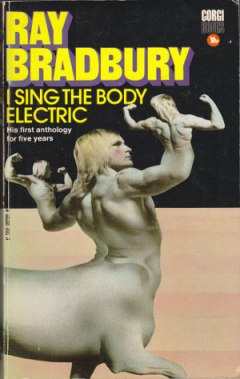
[I]f you’re my age, then you must remember the Twilight Zone episode ‘I Sing the Body Electric’. The script was written by none other than scifi icon, Ray Bradbury, who based the title on a Walt Whitman poem of the same title. The TZ episode featured three children who had lost their mother, so their father took them to a place called Facsimile Ltd. to design their very own robot ‘grandmother’. If you’ve not seen the program, I won’t spoil it, but you’ve learned enough to realize why I’ve chosen to title this post ‘I Sing the Brain Electric’.

In 1969, Bradbury wrote a short story, based on his Twilight Zone script. The cover for that anthology is shown at the right. Is it just me, or does the imagery invoke a chilling connection to Genesis 6 and the fallen angel incursion? Many who follow Bible prophecy expect a return to those diabolical days, but those who look only to biological hybridization might miss a darker, more sinister incursion.
As I write this, it occurs to me just how dependent you and I now are on computerized devices. Our cars, appliances, phones, desktop and laptop computers and tablets (and, yes, even our pets to a certain degree–think of all those chipped animals) interface with us through a growing kind of proto-intelligence. The grandmother in ‘I Sing the Body Electric’ confessed to being just a robot, but she interacted with the children no differently than any human, flesh and blood grandmother might have done, with the exception that she could perform magic tricks, answer any question, and would never die. My computer remembers where I’ve been and predicts where I’d like to go (through internet social media tracking). I have forgotten more passwords than I can count, but my computer can recall them or retrieve them as needed. My tablet computer brings me news at the touch of a button or provides a movie, television program, or podcast on demand. Our lives have been enriched while our minds grow increasingly intertwined with silicon ‘grandmothers’.
Singularity advocates such as Ray Kurzweil and George Church promise us a semi-divine future through technology. Kurzweil hopes to upload his personality, thoughts, and memories to an eternal body just like the Facsimile Lrd. grandmother’s ‘mind’ could be uploaded to whatever body a family designed. To accomplish this, computer software must ‘evolve’ into a nearly sentient entity. If you think this could happen only in the Twilight Zone, the consider an article at Science Daily, dated January 29, 2013:
Engineers Solve a Biological Mystery and Boost Artificial Intelligence
By simulating 25,000 generations of evolution within computers, Cornell University engineering and robotics researchers have discovered why biological networks tend to be organized as modules — a finding that will lead to a deeper understanding of the evolution of complexity.
The new insight also will help evolve artificial intelligence, so robot brains can acquire the grace and cunning of animals.
The article centers on a recent report regarding ‘modularity’, a concept familiar to evolutionary biologists. This concept states that complex entities such as plants, animals, and humans are based upon modular organizational design because that is more readily adaptable. However, a paper published in the Proceedings of the Royal Society disputes this. Hod Lipson of Cornell, Jean-Baptiste Mouret of the Université Pierre et Marie Curie in Paris, and Jeff Clune from the University of Wyoming authored the report. Their research has shown that any network that ‘cost’ will organize into modules.
“Once you add a cost for network connections, modules immediately appear. Without a cost, modules never form. The effect is quite dramatic,” says Clune.
Reading the article might lead one to believe that all entities are equal in this. Whether a human, a tree, or a computer network–all organize into modules, therefore one can group them all into one big evolutionary basket.
From brains to gene regulatory networks, many biological entities are organized into modules — dense clusters of interconnected parts within a complex network. For decades biologists have wanted to know why humans, bacteria and other organisms evolved in a modular fashion. Like engineers, nature builds things modularly by building and combining distinct parts, but that does not explain how such modularity evolved in the first place. Renowned biologists Richard Dawkins, Günter P. Wagner, and the late Stephen Jay Gould identified the question of modularity as central to the debate over “the evolution of complexity.”
Human exceptionalism completely escapes evolutionary scientists. We are nothing more than a collection of processes–genetic, metabolic, reproductive. We are carbon-cased versions of the Facsimile Ltd. grandmother, sans the tricks and immortality. However, we can soon interface eternally with a graphene and silicene based body. Artificial intelligence is coming, dear friend. And God’s beautifully designed, Spirit-breathed Adam and Eve must soon give way to Cylon perfectionism–the ultimate ‘Body Electric’.
Read the entire Science Daily report here: Engineers solve a biological mystery and boost artificial intelligence.
